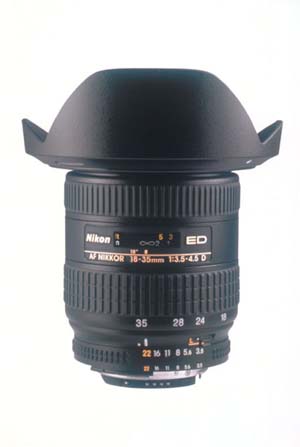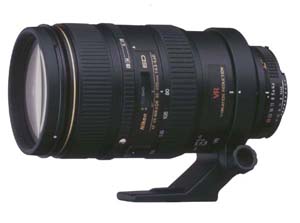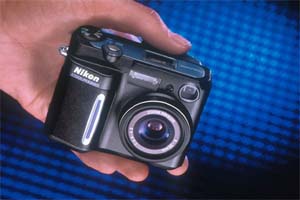Lenses for Digital
(2002 Article)
With all the fuss about pixels and Raw files, we're in danger of forgetting
one of the most important elements in our photo systems--the lens!
The first reason most of us leapt at buying a Nikon D1 family camera was that
we could keep our hard earned lenses. They are the bread and butter of our
photography.
It would be easy to stop at that point, merrily using our existing lenses
with the D1 family. But, particularly for those of us who need to lug our gear
all over the country, or perhaps for folks who haven't spent the big $$ on fast
glass there is more that we can gain from digital.
| First, since in most shooting situations we'll have a faster effective film
speed (ISO setting) we can get more done for a particular f/stop. That doesn't
mean that fast lenses aren't important. In particular the depth of field
requirements to isolate a subject with a telephoto lenses are just as important
as with film. But for many of our wide-angle and 'normal' perspective lenses we
can get by with a little less speed in the lens. This saves us nearly half of
the weight and over half of the cost in some cases. Great examples are the Nikon
18-35mm and Nikon 24-85mm zoom lenses which are very effective replacements for
their AF-S counterparts when used with a D1 family camera. Second, the 1.5x focal length multiplier lets us get by with a little less in
the way of native focal length. Obviously this means we can get that much closer
optically and isolate our subject further, but it may also mean we can get by
with less glass. While this one is obvious, the third effect may not be.
|

Nikon 18-35mm Zoom
|
Third, because the CCD is smaller than a 35mm film frame, most of the light
comes through the center portion of the lens. In particular light fall-off that
occurs in the corners of most lenses is essentially eliminated. In an ideal
world Nikon could use this fact to build us some smaller and lighter lenses
designed especially for the D1 family, but since we all expect CCDs to get
larger again and view the focal length multiplier as temporary we're stuck
carrying around larger lenses than we need. But we can often get away with
slightly lower quality optics because we don't need the extra work that the lens
manufacturer needs to put into preventing light falloff or corner distortion.
|

Nikon 80-400VR zoom
|
A combination of these factors helps make the 80-400VR a great alternative to
the 80-200, despite the latter's legendary sharpness and optics. Of course,
these same factors also make high quality Teleconverters more useful than ever,
especially the Nikon AF-I and AF-S TCs. On a D1 the 80-200 and a 2x TC makes a
240-600f/5.6 lens! So there are benefits to digital for both the heavy AF-S
glass and the lighter alternatives. |
Fourth, there is a slight blurring filter in front of the CCD in almost all
digital cameras. This is to minimize errors from high-resolution (also thought
of as high-frequency) objects when imaged onto the monochrome CCD. You can learn
more about how all this works in the upcoming book Moose and I have written on
the D1 Generation. But it has the side-effect of
artificially limiting how sharp the image can be when initially captured. That
means that lens sharpness above a certain resolution is essentially wasted. Note
that as camera designs get better this effect will lessen, but for now it means
that many lenses which can be told apart when used with a very high resolving
film may image identically on a D1 CCD.
However, there is a downside to using our current lenses with digital. The
fifth factor which influences how your lens will perform on a current generation
digital camera is the most esoteric. Because digital cameras rely on a separate
color filter array (CFA) placed in front of the CCD to create their notion of
scene color, they are subject to a unique form of distortion. Light falling
straight down on a pixel comes through the appropriate color cell and is
correctly measured. But light coming from an angle may come through a different
color cell in the filter, and the camera will be measuring the wrong color. As
you probably know from looking at all of the focus diagrams in photography
books, with a traditional lens light comes through many different parts of a
lens to reach a particular point. You can verify this by focusing 'through' an
object to a farther one.
| For film cameras, now that lenses have been designed that minimize the
distortion of different colors of light bending differently, there isn't much of
a problem if we use high-quality optics, since the film itself contains the key
to imaging different colors. But for digital the result can be color
inaccuracy--normally visible as reduced saturation--or in extreme cases even
color fringing. There is a design for lenses which minimizes this effect. It is
called Telecentric lens design, and involves only letting through light which is
perpendicular to the CCD. The result is that the light travels straight through
the correct cell of the color filter and color distortion and fringing is
avoided. Some lenses have been designed specifically for digital or other color
critical applications and are Telecentric. Nikon's Coolpix 880, for
example, uses a Telecentric lens design. However, since all of our current
F-mount lenses were designed and built for film cameras where this wasn't an
issue, they aren't designed to be Telecentric. The result is some of the color
distortion and fringing you've seen in the test targets captured with the
digital cameras and posted to sites such as wwww.dpreview.com. |

Nikon Coolpix 880 |
So, what does all this mean for you, the digital shooter? Mostly that you
have lenses that will work better than ever on your digital camera, and that you
might be able to save some money weight by moving to lighter and less
expensive--although still high-quality--optics. And that in the long term you
can expect to see lines of lenses marketed as being "designed for digital" with
aggressive progams from manufacturers such as Nikon encouraging you to upgrade!
--David Cardinal, 8/7/01
|